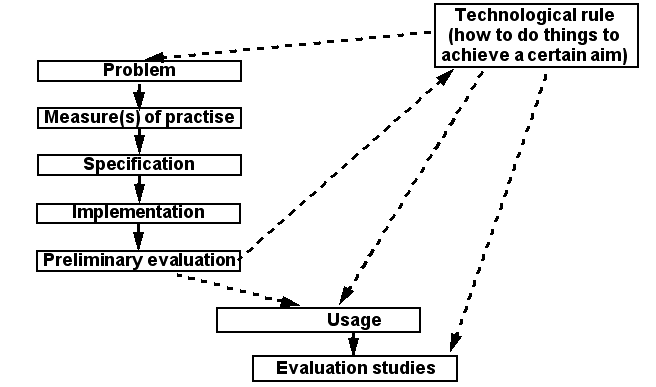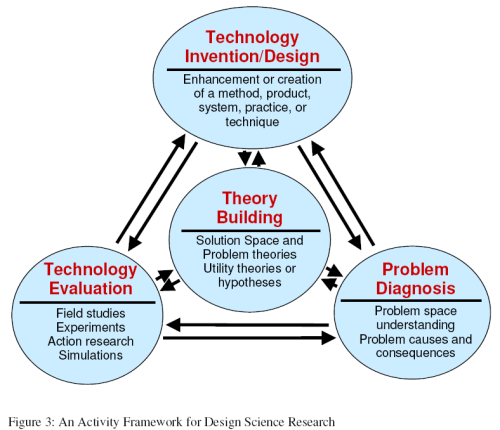Design science
Definitions
- Design sciences related to disciplines that build things.
- “Design is an interdisciplinary and integrative process constituting an intellectual field of thinking and research and a professional field of practice and applied research. Therefore, design research will play one of two roles: (1) the scientific study of the process and the content of design, and (2) the development of methods and tools to enhance the quality of design practice based on the body of knowledge developed by the scientific study” (J. of Design Research Home Page, retrieved, 17:17, 15 September 2006 (MEST)
- “The design of new products drives to solve problems which solutions are still partial and which tools and methods of assistance are rudimentary. Design is applied in extremely various fields and implies numerous agents during all the process of elaboration and realisation” Intl. J. of Design Sciences & Technology home page, retrieved, 17:17, 15 September 2006 (MEST).
See also:
Key elements of design-oriented approaches
The Järvinen model
(according to Pertti Järvinen, 2004)
- Technological rules
- tell you how to do things and are dependant on other theories (and beliefs)
- Bunge (quoted by Järvinen:99): "A technological rule: an instruction is defined as a chunk of general knowledge, linking an intervention or artifact with a desired outcome or performance in a certain field of application".
- Types of outcomes (artifacts, interventions):
- Constructs (or concept) form the " language " of a domain
- Models are sets of propositions expressing relationships among constructs
- Methods are a set of steps to perform a task (guidelines, algorithms)
- Instantiations are realizations of an artifact in its environment
- Types of research:
- Build: Demonstrate feasibility of an artifact or intervention
- Evaluate: Development of criteria, and assessment of both artifact building and artifact usage
What does this mean ?
- There are 4*2 ways to lead interesting design research.
- Usually, it's the not the artefact (i.e. program or course) you build that is interesting, but something behind it (constructs, models, methods, ...) or around it (conditions, perceptions, usage, ...).
Here is picture that shows some of the relationsships between elements of a design process:
- A researcher can investigate at least on of the dotted lines
- A design rule (technological rule in terms of Järvinnen) is a theory on how to build things. It be input, output or both in a research project. See also design-based research that has become popular in educational technology research.
- Note that the "problem" to "evaluation" sequence is itself a design rule, i.e. a design methodology.
- See instructional design models and instructional design method for designs and methods related to education.
Venable's model
Figure 3 shows how theory building is a central activity related to problem diagnosis, technology invention or design (to solve problems), and technology evaluation. While problem diagnosis and technology evaluation may be undertaken in the empirical domains of natural and particularly social/behavioural sciences, theory building is the necessary link between them all. (Venable 2006: 16)
R.B. Fullers' Design Science Methodology
Sometimes design science is associated with R. Buckminster Fuller's problem solving approach that aims to improve global life-quality (ecology).
The function of what I call design science is to solve problems by introducing into the environment new artifacts, the availability of which will induce their spontaneous employment by humans and thus, coincidentally, cause humans to abandon their previous problem-producing behaviors and devices. For example, when humans have a vital need to cross the roaring rapids of a river, as a design scientist I would design them a bridge, causing them, I am sure, to abandon spontaneously and forever the risking of their lives by trying to swim to the other shore.
- Buckminster Fuller from Cosmography as cited in BFI Design Science retrieved, 17:17, 15 September 2006 (MEST)
Types of design research
Van den Akker (1999:3) presents the following not exhaustive list of "natural kinds" and also points out that "the situation is rather confusing":
- Design studies; Design experiments; Design research;
- Development/Developmental research;
- Formative research; Formative inquiry; Formative experiments; Formative
evaluation;
- Action research;
- Engineering research.
After a longer discussion of various design and development activities that happen in in development research, van den Akker (1999:6) suggests to categorize development research within two categories:
- Formative Research. Research activities performed during the entire development process of a specific intervention, from exploratory studies through (formative and summative) evaluation studies; aimed at optimization of the quality of the intervention as well as testing design principles.
- Reconstructive Studies. Research activities conducted sometimes during, but oftentimes after the development process of several interventions; focused on the articulation and specification of design principles.
The author also add a Explorative Design Studies category, but since these studies do not aim to generalize they don't qualify as academic research. “These activities, preceding the actual development work, aim at clarifying the design problem-in-context and at generating tentative design ideas. Such explorations can be very valuable in directing the development work.” (van den Akker, 1999:6)
Various issues
Design science in the digital age
“Being digital has begun to affect the way we represent, present, communicate about, and materialize our designs by integrating media in the conceptualization, realization, communication, and production of designs. [...] Furthermore, digitally mediated design is becoming inter-related with concepts of the virtual. Virtual design environments are becoming increasingly immersive, knowledge rich, and intelligent. [...] Digital design thinking is now emerging as the set of phenomena that characterize the way in which the digital designer is beginning to think, employing digital tools and interacting with representational media. His mediated work-place and his electronic community are becoming his expanded e-identity.” (Oxman, 2006: 225)
See also: social computing and virtual environments. There should be an article on collaborative design environments.
The status of theory
Theories are design artefacts. The outcome of research is often formulated as theory; that is, highly universal representations, pretending to be independent of concrete context, practice or situation. From the point of view of design, theories are design artefacts, taking different roles in design; from worldviews, guiding the designer and helping him assess the situations and keep the goals in mind, to tools mediating the achievement of specific results. In this way, the direct outcomes of research mediate design. (Bertelsen, :23).
Links
- [1]. Design and Science Community (maintained by Christoph Bartneck, an HCI, social robotics, etc. expert)
Associations and journals
- Design Sudies, The International Journal for Design Research in Engineering, Architecture, Products and Systems, (Access restricted).
- Journal of Design Research (JDR), SSN (Online): 1569-1551 - ISSN (Print): 1748-3050. (Access restricted)
- Journal of Design History (some issues online).
- Design Issues (Access restricted) (some samples)
References
- Pertti Järvinen: On Research Methods. Tampere: Opinpajan Kirja, ISBN 952-99233-1-7 .
- Note: This seems to be the only useful methdology book related to design-oriented research. Very dense reading, but worth to buy, directly from here (no other place sells it): http://www.uta.fi/taju ... a small and friendly university bookshop (tested by me).
- Olav W. Bertelsen, DESIGN ARTEFACTS, Towards a design-oriented epistemology, Scandinavian Journal of Information Systems, 2000, 12: 15-27 15 PDF
- Oxman, Rivka (2006). Editorial - Special Issue of Design Studies on Digital Design Design Studies Volume 27, Issue 3 , May 2006, Pages 225-227.
- Sven A. Carlsson, (2006) Towards an Information Systems Design Research Framework: A Critical Realist Perspective, First International conference on Design Science Research in Information Systems and Technology. http://ncl.cgu.edu/designconference/index.htm
- Venable, John R. (2006) The Role of Theory and Theorising in Design Science Research, http://ncl.cgu.edu/designconference/index.htm
- Van Aken, J.E. (2004): Management research based on the paradigm of design sciences: the quest for field-tested and grounded technological rules, Journal of Management Studies, 41(2), 219-246.
- Akker van den, J. (1999). Principles and Methods of Development Research. In J. Akker, van den, R. Branch et al. (Eds.) Design Approaches and Tools in Education and Training (pp. 1-14). ico, Kluwer Academic Publishers. PDF
- Reymen M. M. J., D. K. Hammer, P. A. Kroes, J. E. van Aken, C. H. Dorst, M. F. T. Bax and T. Basten (2006), A domain-independent descriptive design model and its application to structured reflection on design processes, Research in Engineering Design, 16 (4), 147-173. Abstract PDF/HTML (Access restricted) (This is also a good overview article)
- Zeisel, J. (1981). Inquiry by design: tools for environment-behavior research. Monterey, California: Brooks/Cole Publishing Company.

